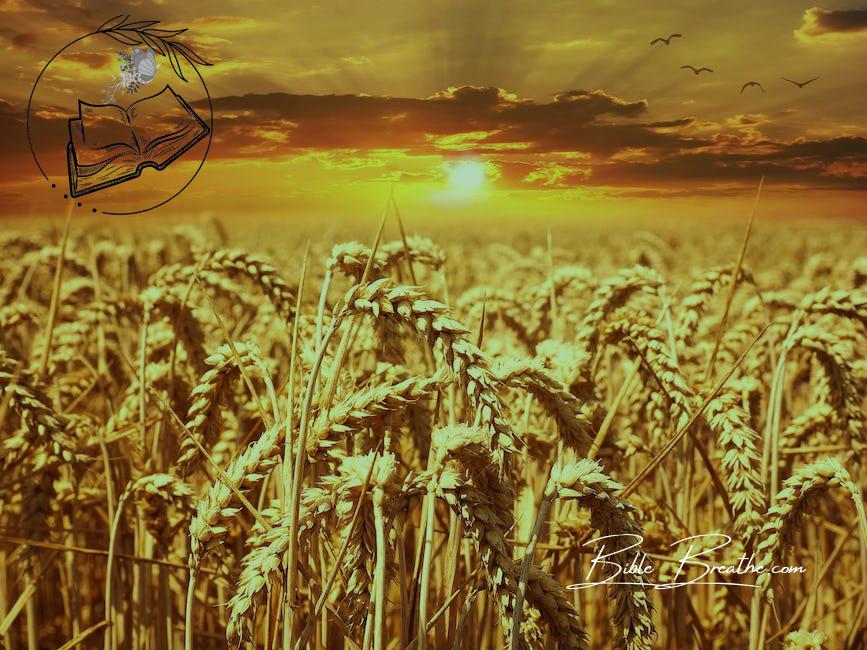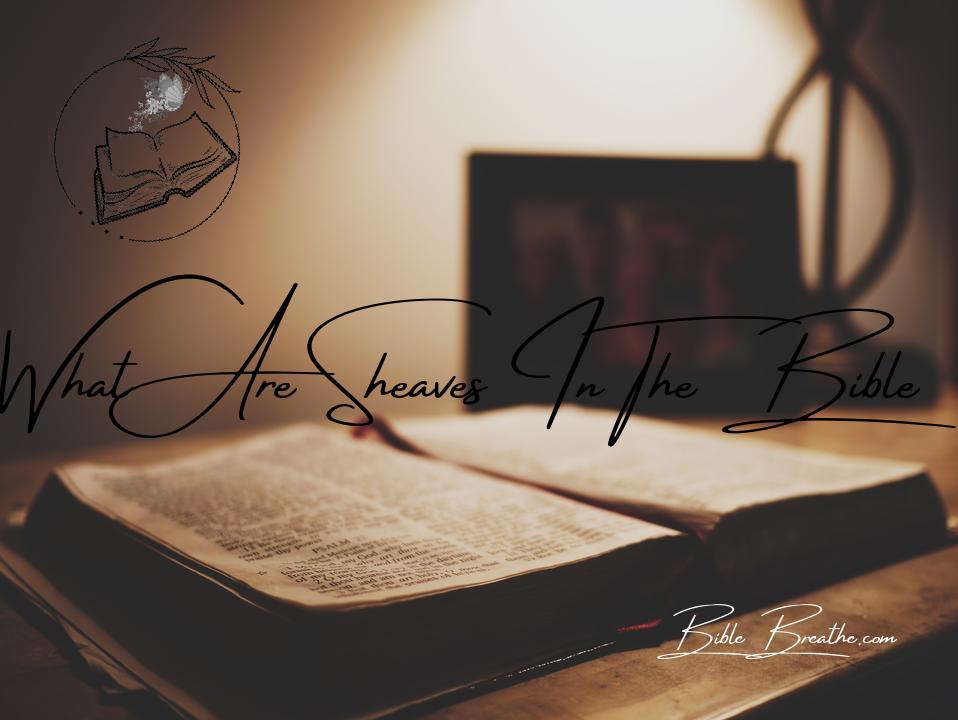What are sheaves in the Bible?
Picture this: sheaves are like God’s love notes, scattered throughout Scripture.
These bundles of grain are like heavenly postcards, showing up time and time again.
You’ve got your basic ingredients: barley and wheat – God’s recipe for abundance.
These sheaves are the harvest’s MVPs, representing worship and sacrifice.
From the book of Leviticus to the poetic verses of Psalms, they’re all about blessing, teachings, and eternal truths, like a spiritual resurrection.
Remember, they’ve got a VIP pass to Jerusalem and are the stars of the Feast of Unleavened Bread and Shavuot.
But what’s the takeaway for us today?
These sheaves hold a treasure trove of wisdom, like a field full of blessings and abundance waiting to be reaped.
Let’s dive into this harvest of knowledge together! 🌾📖
Key Takeaways
- What are sheaves in the Bible? Sheaves in the Bible carry multifaceted significance. They are a symbol of the harvest, representing the fruits of one’s labor and the blessings of God. In agricultural societies, sheaves were bundles of harvested grain, and their abundance was a sign of prosperity.
- Beyond their practical meaning, sheaves hold spiritual implications in the Bible. They are used metaphorically to represent people and their destinies. The story of Joseph’s dream, where his brothers’ sheaves bowed down to his, illustrates this symbolism, signifying his future leadership.
- Sheaves also have cultural and traditional importance in religious contexts. They were used in various religious rituals and ceremonies in ancient Israel, emphasizing the connection between faith and daily life. The practice of offering sheaves as a thanksgiving offering underscored the importance of acknowledging God’s provision.
- The concept of sheaves encourages believers to reflect on the blessings and abundance in their lives, recognizing that all good things come from God. It reminds them of the spiritual lessons found in everyday experiences and the connection between their faith and daily work.
- Exploring what sheaves mean in the Bible invites a deeper understanding of the intertwining of practical, spiritual, and cultural elements in biblical narratives, encouraging believers to appreciate the rich symbolism and lessons embedded in this agricultural symbol.
Unpacking the Bible’s Take on Sheaves: Barley and Wheat

Photo modified by BibleBreathe.com. Original photo by Pixabay on Pexels
Hey there, fam!
We’re diving into the Word to break down what those “sheaves” in the Bible are all about.
I’m here to make it as clear as crystal, especially for our young guns and adults seeking some biblical wisdom.
Barley Sheaves: Offering Up Your Best
Let’s kick things off with the sheaf of barley.
This is like that special gift you save to give to someone you truly care about, just like how we give our best to the Creator.
Think about it this way: you’ve got a garden, and you’re growing all sorts of crops.
Barley?
It’s that juicy, ripe apple right at the top of your tree, waiting to be picked.
It’s a symbol of offering, a gesture of your love and respect for the Almighty.
“When you bring in the harvest of your land, don’t scrape the fields clean or pick up the grain that falls on the ground. Leave it for the poor and for those foreigners who live among you. I am the LORD your God.” – Leviticus 19:9-10 (ESV)
Barley was a part of the offerings during the Feast of Unleavened Bread.
It’s like our way of saying thank you to God for the good things in our lives.
Wheat Sheaves: Overflowing Blessings
Now, let’s talk about the sheaf of wheat.
Wheat is like that endless pasta bowl at your favorite Italian restaurant – it just keeps coming, right?
Imagine this: a field of wheat, standing tall and golden, ready to be harvested.
It’s nature’s way of shouting, “Here’s a harvest to feed the world!” Wheat symbolizes God’s blessings and the abundance of life.
It’s like when you’re at a buffet, and the food keeps rolling in, and you never run out.
“I tell you the truth, unless a kernel of wheat is planted in the soil and dies, it remains alone. But its death will produce many new kernels – a plentiful harvest of new lives.” – John 12:24 (ESV)
Wheat is deeply connected to Jesus.
He’s often called the “bread of life.”
That’s because He’s the source of all the good stuff, the ultimate provider in our lives.
So, what’s the deal with sheaves in the Bible?
They’re like symbols of gratitude, abundance, and God’s never-ending goodness.
Barley and wheat, just like those secret ingredients in grandma’s famous recipe, add flavor and depth to our journey of faith.
Unpacking the Spiritual Treasure of Sheaves

Photo modified by BibleBreathe.com. Original photo by Ksenia Chernaya on Pexels
Hey there, my wonderful family!
Today, we’re about to dive deep into a topic that might seem simple at first glance: sheaves.
But trust me, there’s so much more to these bundles of goodness than meets the eye.
Let’s break it down and understand the spiritual significance they carry in the Word.
God’s House in the Fields
Now, when you think of sheaves, think of them as God’s little bundles of blessings out in the fields.
You see, they’re not just crops bundled up; they symbolize the very house of worship.
Imagine it like this: just as these sheaves are bound together, God’s people come together as a strong, supportive community, all under the same roof of faith.
Sheaves: Treasure Chests of Truth
Here’s the real gem: sheaves are like treasure chests filled with teachings containing truth.
Those teachings, my friends, are like the grains within those sheaves – valuable, nourishing, and full of wisdom.
Think of the Bible as the ultimate treasure map.
It’s up to us to harvest these truths, recognizing their worth and embracing their significance in our lives.
Psalms 126:5-6: A Key to the Mystery
Now, let’s unlock a mystery together.
Psalms 126:5-6 drops a beautiful truth bomb on us:
“They that sow in tears shall reap in joy. He that goeth forth and weepeth, bearing precious seed, shall doubtless come again with rejoicing, bringing his sheaves with him.” – Psalms 126:5-6 (KJV)
What’s King David trying to tell us here?
It’s like sowing seeds of faith in the tears of trials and challenges.
When we bear precious seeds of truth and share them, there’s a promise of joy in the harvest.
Our lives, my friends, are like the farmer’s field, and the Word of God is our precious seed.
The sheaves we carry are the spiritual bounty we reap when we share these divine teachings with joy.
In a nutshell, sheaves in the Bible are far more than mere bundles of crops.
They symbolize unity, truth, and the incredible harvest of divine wisdom.
Just as a farmer’s hard work is vital for a plentiful harvest, our dedication to understanding and sharing the Word is essential for a spiritual abundance in our lives.
So go out there, share those sheaves of wisdom, and let the joyous harvest begin!🌾🙌
Unveiling the Mystery of Sheaves in the Bible: God’s Harvest Pulley

Photo modified by BibleBreathe.com. Original photo by cottonbro studio on Pexels
Hey there, fam!
Ever seen a pulley at work?
Picture a well-oiled machine lifting heavy stuff, making it seem like a piece of cake.
Well, understanding sheaves in the Bible is like getting a grip on a vital part of that spiritual machinery, making everything work smoother than your favorite song on a sunny day.
The Sheave: Harvest Bundles of Blessings
Alright, let’s break it down.
A sheave is like a bundle of harvested goodness, think barley or wheat all tied up and ready to roll.
It’s like God’s gift basket, full of the fruits of our hard work and faith.
Imagine it – a bunch of blessings, all bundled up and ready to be lifted to a higher level of abundance.
The Lowdown: Sheaves vs. Pulleys
Let’s clear this up – a sheave is that bundled goodness, while a pulley is like your spiritual GPS, guiding and lifting you up.
Just like a pulley helps move heavy stuff with ease, understanding sheaves helps us understand how our efforts and God’s plan sync up.
In Leviticus, offering sheaves during the Feast of Unleavened Bread and Shavuot was like saying, “God, look at these blessings, and thank You!”
It’s a way of showing appreciation for the bountiful harvest He’s blessed us with.
“When you’re reaping your harvest, don’t scrape every last bit. Leave some for the folks in need. That’s how we roll, with gratitude and sharing the goodness.” – Leviticus 19:9-10 (KJV)
These sheaves teach us about giving, about being grateful, and about recognizing God’s hand in our blessings.
So, fam, gather up your sheaves of good deeds and thanksgiving.
Know that God’s got the pulley ready, lifting you to higher grounds of abundance and blessing.
It’s a spiritual harmony, and we’re all part of this awesome symphony! 🎶
Unveiling the Bounty: Sheaves in the Bible and Popular Culture

Photo modified by BibleBreathe.com. Original photo by Rene Asmussen on Pexels
Hey there, fam!
Let’s dig deep into something that might not be as “shout it from the mountaintops” common as “love” or “faith,” but oh, it’s got wisdom woven in, like a golden thread in a tapestry.
Harvest Time: The Symbolism of Sheaves
Imagine you’re out in the fields, ready to harvest, standing tall amongst fields of barley and wheat.
You’re bundling the ripe crops into sheaves.
These sheaves aren’t just bunches of crops; they’re a symbol.
They’re a symbol of hard work paying off, a symbol of patience rewarded.
In the Bible, sheaves are like gold nuggets of abundance and prosperity.
Is it a small matter that thou hast taken my husband?” – Genesis 30:15 (KJV)
These sheaves in the Bible, they represent abundance—God’s abundance.
They shout out loud: “Look at the harvest, look at the blessings, see how faithful God is!”
A Melodic Tribute: “Bringing in the Sheaves”
Let’s jam to an old, timeless hymn—ever heard of “Bringing in the Sheaves”?
It’s a song that paints the picture of gathering, reaping, and joyfully celebrating the harvest.
Just like the joy of reaping a bountiful harvest, this song captures that same joy in faith.
Harvesting Wisdom: Unpacking the Song’s Origins
Imagine this song is like a musical sheave—it’s a bundle of faith-filled notes, tied together with the promises of God.
Inspired by Psalm 126:6, it’s a joyful echo of harvesting our faith and reaping the rewards of our belief.
“He that goeth forth and weepeth, bearing precious seed, shall doubtless come again with rejoicing, bringing his sheaves with him.” – Psalm 126:6 (KJV)
The song paints a vivid picture of our spiritual journey—it’s like planting seeds, tending to them, and finally, rejoicing as we gather the sheaves of our faith.
It’s a melody that lifts us up and reminds us of the bountiful blessings God has in store for us, just like a harvest bursting with goodness.
So, let’s vibe with the timeless wisdom—sheaves aren’t just stalks of crops.
They’re a shout-out to faith, hard work, and the amazing blessings God has in store for those who keep the faith and tend to their spiritual fields.
The Power of Sheaves in Hebrew Tradition

Photo modified by BibleBreathe.com. Original photo by I Gede Karsa on Pexels
Hey there, fam!
Today, we’re diving into a treasure trove of biblical symbolism—the sheaves.
It’s like unearthing a hidden gem in the harvest fields, and believe me, it’s loaded with spiritual significance.
Unveiling the Hebrew Term: Let’s Break It Down
Now, when we talk about ‘sheaves’ in Hebrew, we’re talking about more than just bundles of grain.
It’s like calling a roaring ocean ‘just water.’ The term ‘sheaves’ speaks of a gathering of hard work, faith, and patience, promising a fruitful harvest.
Picture it: a field bursting with ripened grain, a harvest ready for the picking.
That’s the essence of sheaves.
Sheaves and Offerings: A Sacred Connection
Ever seen a farmer presenting the best of his harvest?
It’s a gesture of gratitude, right?
In much the same way, the Hebrews presented sheaves as offerings—a way of saying ‘thank you’ for the bountiful harvest.
These sheaves weren’t just stalks of grain; they symbolized a spiritual harvest, a celebration of God’s goodness.
The Priesthood’s Role: Guardians of the Harvest
Now, think of the priesthood as the vigilant guardians of the harvest.
Like watchful shepherds over a flock, they ensured the sheaves were presented with care and reverence.
They were the caretakers, the stewards, entrusted with this sacred task.
It’s like they were nurturing the link between the people and their Creator, ensuring the offering was a genuine reflection of gratitude.
In the grand tapestry of Hebrew tradition, sheaves aren’t just agricultural artifacts.
They’re threads of faith and gratitude, intricately woven into the fabric of offerings and spirituality.
A sheaf isn’t just a bunch of crops; it’s a symbol of faith, a reminder of the cycle of life—sown, nurtured, harvested, and offered back to the Provider of all good things.
And thou shalt observe the feast of weeks, of the firstfruits of wheat harvest, and the feast of ingathering at the year’s end.” – Exodus 34:22 (KJV)
Frequently Asked Questions (FAQs) About What Are Sheaves In The Bible
What is the difference between a sheaf of barley and a sheaf of wheat?
Barley and wheat sheaves are distinct grains mentioned in the Bible, each with its own significance in agricultural and religious contexts.
How are sheaves used in pulley systems?
Sheaves in pulley systems are used to change the direction of force, making it easier to lift heavy objects.
They reduce the amount of effort needed to raise or lower loads.
What is the significance of the song “Bringing in the Sheaves”?
Bringing in the Sheaves is a Christian hymn inspired by Psalm 126:6.
It metaphorically refers to reaping the harvest, signifying joy and celebration in bringing souls to God.
The song embodies the spiritual concept of sowing seeds, spiritual labor, and the reward of gathering the ‘sheaves’ as souls saved for the kingdom.
How are sheaves related to Hebrew offerings?
Sheaves in Hebrew offerings symbolize abundance and gratitude.
In the Old Testament, presenting sheaves as offerings signified the acknowledgment of God’s provision and bounty.
It reflects the agricultural context of ancient Israel, emphasizing dependence on God for sustenance and expressing gratitude through offerings.
Matt Turner
I’m Matt, and I love breaking down Bible verses in a way that’s easy to understand and apply to everyday life. My goal is to help you connect with God’s Word and find practical ways to live it out. Whether you’re new to the Bible or just looking for some fresh insights, I’m here to walk with you and share what I’ve learned along the way.

